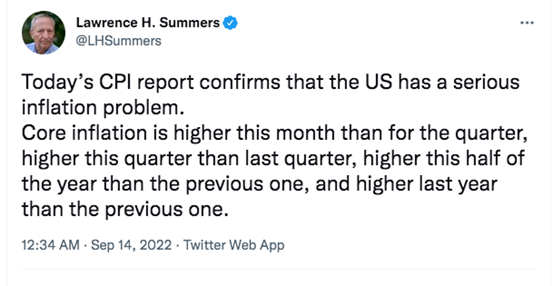- The August month-on-month-consumer price reading is 0.6%, twice the expectation of 0.3%.
- Investors fearing accelerated and sharper rate hikes hit the sell button en masse.
- What is driving the selloff, and can we expect the selling to continue?
Sticky inflation
The August month-on-month print of the consumer price index came in at 0.6%, or 7.2% annualised. Well above the 0.3% or 3.6% analysts expected.
Wage inflation is sticky, at above 5% in a tight labour market, and the higher raw material prices of earlier in the year are starting to be baked into final consumable item sale prices.
Former US Treasury Secretary Lawrence Summers had this to say:
Yet oil prices have retreated, and gas prices plateaued for US consumers from June this year. Grains and cereals though elevated, have retreated from mid-year highs on the promises of the security of Ukrainian exports.
Top Australian Brokers
- City Index - Aussie shares from $5 - Read our review
- Pepperstone - Trading education - Read our review
- IC Markets - Experienced and highly regulated - Read our review
- eToro - Social and copy trading platform - Read our review
As prices were racing higher earlier in the year, there was a sense that supply lines were being disrupted indefinitely. Corporate procurement managers feared being shut out and locked in supplies; these elevated costs are now being passed on to the consumer. It will take some time before the retracements are passed on, and we are now seeing the time-lagged effect in the price rises.
Policy in hindsight
The Federal Reserve and other policymakers that set benchmark borrowing and lending rates pay extremely close attention to the historical data prints and allow the data to inform the direction interest rates will go.
When prices are moving gradually, the data first approach allows the setters of interest rates to adjust the market with a softly-softly attitude so as not to derail the price of assets.
The one drawback of applying policy with hindsight is that it removes the ability of policymakers to get ahead of the data when prices are moving so quickly.
The primary fear of the market right now is that interest rate setters will overcorrect for the recent slew of data.
Market anticipation
Markets are inherently forward-looking beasts. They bundle all the information at hand and provide a valuation projection for the listed security.
Right now, we have a clash between a cohort of interest rate setters witnessing sharp rises in the price of consumable items and investors fearing further devaluation of their investments under anticipated higher costs of capital.
Impact on the markets
The dual fear of the increased probability of sustained inflation and an over-correction from the Federal Reserve sent the US stock market down on Tuesday.
The more interest rate-sensitive NASDAQ closed down over 5% on its worst day since June 2020.
Australia’s S&P ASX 200 opened lower by 2.5%, and most other Asian indices were down by a similar amount.
Outlook
The market selloff can equally be attributed to the anticipated reaction of the Federal Reserve in raising rates higher for longer than the true expectations for inflation.
It is possible that the inflation data will start to cool in line with the raw material price selloff from June, but many investors were not sticking around to find out.






